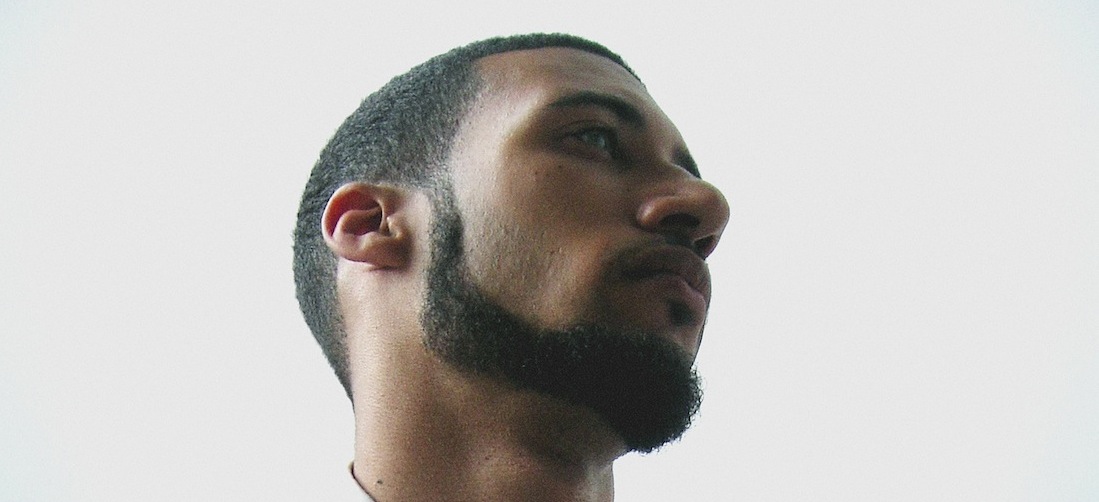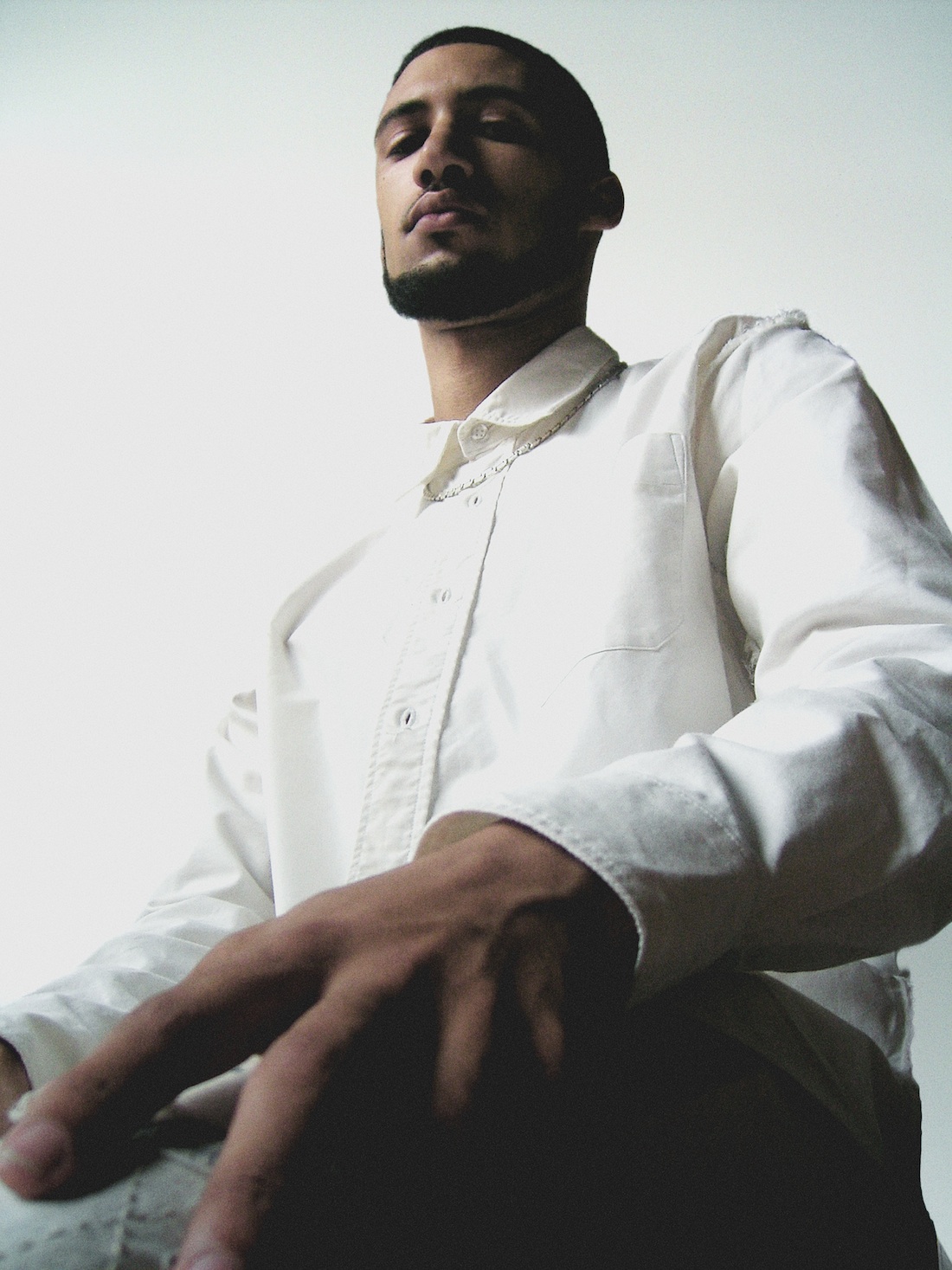Interview: Visionist
On his new album, the London producer pushes back with a foray into abstract territory.

Interview: Visionist
On his new album, the London producer pushes back with a foray into abstract territory.

“I remember when rosary beads became popular and I was like, ‘Nah, I don’t want normal rosary beads. So I went and bought beads and got rosary beads made.’” Louis Carnell creases up at the memory, laughing through the visible cringe. Questionable millennial fashions aside, the South London producer clearly had his own way of doing things, even as a teenager. Today, sitting opposite XLR8R in a no-frills Brixton pub, his statement vintage specs and concept selvedge denim certainly stand out amid the daytime drinkers and expanse of sticky, pine-effect surfaces. But if you really, truly want to understand how deep his aversion to rote ideas and off-the-peg style runs, perhaps the best place to start is his music.
Since 2011, Carnell has been refining and developing his own idiosyncratic sound as Visionist, racking up a number of intriguing and stylistically variegated releases on ahead-of-the- curve labels such as Keysound, Ramp and Leisure System. While he’s always been influenced by the rich seam of music seeded in London’s home turf—in particular the sharp angles and space/density dynamics of grime—his I’m Fine series released on NYC’s Lit City Trax saw him circling a more ambitious sound and conceptual approach. This was galvanized, in part, by a trip to New York in 2012, where the baldly futurist club sounds by the likes of Fatima al Qadari (with whom he collaborated on the first I’m Fine EP) intersect with art, fashion and an online exchange of ideas.Now, with the release of his debut full-length, Safe, on Bill Kouligas’s Pan label, he’s allowed himself to move even further into abstract territory, crafting a work that not only seeks to continue the musical legacy of his city, but also that define who he is as an artist. Take a look at his most recent set of editorial style press pictures, shot by fashion photographer Daniel Sannwald, and you perceive an artist confident with his own identity. Well, almost: Bring up those photos, and Carnell smiles self-consciously—a little awkward, perhaps, but resolute. “I feel now that my music is so strong that now it really is a time to build on an image of who I am,” he says “I don’t need to hide; the music’s there now, now you need to see me as well.”

There’s no doubt that Safe is a highly personal record. Written after a period of particularly debilitating anxiety which saw him cancel a tour in Australia, the record is an attempt to come to redirect the negative energy into something constructive. Although, he admits, his mum still finds it a tough listen: “It’s too personal for her,” he admits. “She got about four tracks in and was like, ‘I can’t do this.’” Certainly, listening to Safe—which aims to trace the arc of an anxiety attach, from trigger to attack and ending in resolution—is an intense experience. His characteristic use of vocal samples, heavily edited and processed, has grown ever more sophisticated, with melodies allowed to unspool, develop and double back. Booming, metallic percussion jab and punch, but there’s few concessions to the dance floor; rather, these are emotional, contested soundscapes where the the organic and synthetic merge—and not wholly without pain. To listen to a track like “Vffected” is to socket into a kind of heightened fear response, and it’s not wholly surprising that London, in all its overstimulated madness, remains a crucial influence for Carnell. “London is not a healthy place to live.” he shakes his head. “I’ve thought about moving from London so many times, but I’ve never done it because as much as it causes me a lot of stress, it also inspires me. If I went to a peaceful place, would I even do anything? I’m so used to having a struggle to keep me going, so when that’s taken away, what do I do?”
Born in Brixton, and currently living down the road in Herne Hill, Carnell spent a chunk of his teenage years in Nottingham where he moved with his mother, a dancer who worked for the Arts Council. Intriguingly, it’s her that he credits with his own fondness for expression. “I used to go to loads of performances as a kid,” he says, reflective for a minute. “I’d probably say that it didn’t really influence me, but it definitely did.” Having used his voice for his music General Certificate of Secondary Education, it was in Nottingham that he first began producing grime tracks and, for a bit, MCing. He was inspired by the groundbreaking sounds coming out of his home town, and particularly identifying with the tracks coming from south of the river (Stockwell-born Dot Rotten has been frequently cited as an influence). After emulating R&B recording artists like Usher for his schoolwork, he quickly found that the more antagonistic role of the MC gave him the perfect outlet to work through his teenage frustrations. “I’m just highly competitive,” he observes. “I was pretty much just saying I was the best all the time; I got quite dark with it. You could tell I was very much frustrated, and very much just like ‘I’m on my own thing, don’t need anyone’—that kind of thing.” He pauses, connecting the dots. “I’m probably still a little bit like that, I just don’t say it as much.”
Despite his quiet demeanor, Carnell has the kind of confidence that comes with having complete faith in what you do, and gives short shrift to those who don’t get it. He bristles when you bring up the new wave of instrumental grime, a much think-pieced and championed movement that has seen a second wave of producers riffing on the original eight-bar sound of grime. It’s a movement that he has been included in, and at times hasn’t necessarily resisted—but the constant comparisons to artists he has little or no affinity with has proved tiring. Asked if he thinks his music has been misunderstood, he answers with the following: “Definitely. It’s been misinterpreted that I wanted to bring back grime when I didn’t at all. There will always be grime tracks because that’s where I’m from, but get further than that and listen to the rest of the music.” He grows animated, “I think I’ve been pigeonholed in one thing and I never wanted to be that. I’ve had tracks like “M” which was my take on techno, and people were calling it grime. I’ve heard it in mixes with people trying to play it at 140 when it’s 125.”
“Nobody wants to talk about [grime] during its great days, until a new generation of people did it, from a different background. And they’re mainly white producers as well. And suddenly it’s all experimental, and all interesting and all new.”
More broadly, Carnell takes issue with the way that the new wave of grime has been praised for its experimentalism in a way that the original music was not. “I think, to be honest, the whole new phase of grime is open to see,” he says. “Nobody wants to talk about it during its great days, until a new generation of people did it, from a different background. And they’re mainly white producers as well. And suddenly it’s all experimental, and all interesting and all new.” Aggrieved, he reserves his attention for artists who, like him, use grime as a starting point and take it somewhere startling and new. His label, Lost Codes, which recently teamed up with Pan to become Codes, was among the first to champion artists such as Filter Dread and U.S. artist SD Laika. “When I first heard SD Laika, I was like, ‘What is this?’ There were bits where I could see where the influences came from, but it was completely new to me, and I put that out early—early—when people still didn’t get it.” He looks indignant. “But I knew it had to be out, that people had to hear it, even if they didn’t get it. Now people are like, ‘Oh yeah, that SD Laika guy.’”
But if Carnell is somewhat disillusioned with the London’s trend-choked musical landscape, you also get the sense that, like the other challenges he’s faced, it’s only serving make him more devout. Instead of upping sticks and moving cities, he’s sees it as his responsibility to dig in and push back—even if he perceives himself as one of the few people still doing it. He hopes that with Safe, people will finally get it, get him and get what he’s trying to do. “I feel like my music is important for London,” he says. “Being from here, keeping the music highly influenced from the sounds I’ve grown up with, but trying to create the new. You know, from jungle to garage to grime to dubstep to bass music, we’re London—we’re the place for music, we always have the ideas,” If he’s angry—and he is—it’s a kind of righteous, constructive anger that’s difficult not to moved by. “I feel like it’s my duty to write music that is forward thinking—as a Londoner.”
Top photo: Daniel Sannwald

